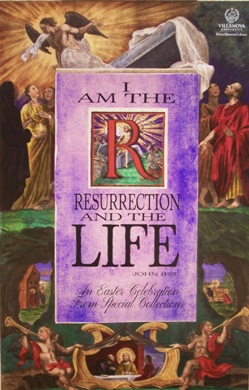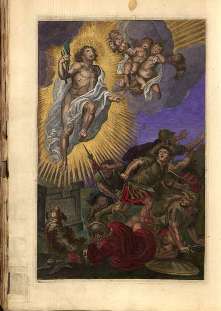I Am the Resurrection and the Life (John 11:25): An Easter Celebration from Special Collections
 Although somewhat smaller than the usual exhibitions presented by Special Collections, “I Am the Resurrection and the Life (John 11:25): An Easter Celebration from Special Collections” is a broadly based display which appeals to viewers on several levels; visual, intellectual and spiritual. Designed by Laura Bang, Special and Digital Collections curatorial assistant, she and Michael Foight, Special and Digital Collections coordinator, mounted the exhibit, which will remain on display through April 10. Joanne Quinn, graphic designer, created posters and other graphics.
Although somewhat smaller than the usual exhibitions presented by Special Collections, “I Am the Resurrection and the Life (John 11:25): An Easter Celebration from Special Collections” is a broadly based display which appeals to viewers on several levels; visual, intellectual and spiritual. Designed by Laura Bang, Special and Digital Collections curatorial assistant, she and Michael Foight, Special and Digital Collections coordinator, mounted the exhibit, which will remain on display through April 10. Joanne Quinn, graphic designer, created posters and other graphics.
In her introduction to the exhibit Bang says, “Easter is considered by many to be the most important observance of the Christian year. … This exhibit highlights some of the materials in Falvey Memorial Library’s Special Collections that pertain to Easter and spring celebrations.” In the same tall vertical case are two small books, The Easter Book of Legends and Stories (PN6071.E2H30), selected by Alice Isabel Hazeltine and Elva Sophronia Smith and illustrated by Pamela Bianco, and Easter Garland (GT4935.L6) by Priscilla Sawyer Lord and Daniel J. Foley provide secular material about Easter: the “Easter Rabbit” and “Foods of the Easter Season.” At the bottom of this case is a colorful poster, “An Easter Celebration from Special Collections,” and two books: Festivals & Rituals of Spain (GT4862.A2G37 1994) by Cristina Garcìa Rodero and The Temple: Sacred Poems & Private Ejaculations by George Herbert, a seventeenth century poet. Festivals… is opened to a colorful double page photograph. The Temple shows “Easter Wings,” concrete poetry in which the text forms a shape which, according to Bang, is “as important an element as the verses themselves.”
 The next case houses a single large volume, a Biblia Latina, more commonly known as the Gutenberg Bible. The Biblia Latina on exhibit is a facsimile, one of only 1,000 printed in the United States in 1961. The original Biblia Latina or Gutenberg Bible was printed by Johannes Gutenberg in Mainz, Germany, in the 1450s using movable type, the first important book printed this way. This Bible began the age of printed books; only 48 copies or partial copies survive. The facsimile is opened to the beginning of the book of Acts “which describes Jesus’ appearance to the Apostles after his Resurrection…,” says Bang. Although the Bible was printed, the colorful decorations continue the tradition of hand-illuminated manuscripts. The colorful decorations on the right-side page are truly spectacular.
The next case houses a single large volume, a Biblia Latina, more commonly known as the Gutenberg Bible. The Biblia Latina on exhibit is a facsimile, one of only 1,000 printed in the United States in 1961. The original Biblia Latina or Gutenberg Bible was printed by Johannes Gutenberg in Mainz, Germany, in the 1450s using movable type, the first important book printed this way. This Bible began the age of printed books; only 48 copies or partial copies survive. The facsimile is opened to the beginning of the book of Acts “which describes Jesus’ appearance to the Apostles after his Resurrection…,” says Bang. Although the Bible was printed, the colorful decorations continue the tradition of hand-illuminated manuscripts. The colorful decorations on the right-side page are truly spectacular.
Another case also houses a single volume and another facsimile: Evangeliorum Quattuor Codex Cenannensis, known as the Book of Kells. The original Kells was probably written and decorated c.800 at a monastery at Kells, Ireland. Today it is housed in the library of Trinity College, Dublin, Ireland. The Book of Kells, a richly illuminated work on vellum (calf skin), contains the Gospels of Matthew, Mark, Luke and John. It was likely intended to be used at the monastic church’s altar. Special Collections’ facsimile is opened to show two of the many illustrations, a colorful Christ in Majesty framed in elaborate Celtic interlace and a cross carpet page. Cross carpet pages are full page cross designs without text; this one incorporates eight circles and is filled with Celtic interlace. These two pages are part of St. Matthew’s Gospel.
On the far right is a case which houses three works: a bound volume of the The Villanova Monthly, the predecessor to the Villanovan; Robert Browning’s Christmas-eve and Easter-day, a book of poetry opened to “Easter-Day” and Little Pollys Pomes [sic], written by T. A. Daly in a child’s voice, showing Polly’s poem, “Easter.” The April 1893 Villanova Monthly features a full page poem, “He Is Risen!” by R.A.G.
 Two additional cases complete the exhibit. One houses three books, two small and the large Missale Romanum (Roman Missal). A Roman Missal is a liturgical book with the texts used in the celebration of the Roman Catholic Mass. The Missale Romanum on display was printed in Antwerp, Belgium, in 1773. It is open to the pages showing on the left Resurrection and on the right the text for the Easter Sunday (Resurrection Day) Mass. One small book, The Lenten Monitor: Or, Moral Reflections and Devout Aspirations on the Gospel: For Each Day From Ash-Wednesday to Easter Sunday, was written by Pacificus Baker, an eighteenth century English Minorite friar; this volume was published in 1834. This book is opened to “Baker’s reflections on Palm Sunday ….” The small book to the right of the Missale Romanum is The Christian Year: Thoughts in Verse for the Sundays and Holydays Throughout the Year. Written by John Keble, a poet and churchman, it was published in 1874 and is open to a poem about Good Friday and a sepia Crucifixion. Although this work is in Special Collections, there is another volume available for circulation (PR4839.K15 C4 1856).
Two additional cases complete the exhibit. One houses three books, two small and the large Missale Romanum (Roman Missal). A Roman Missal is a liturgical book with the texts used in the celebration of the Roman Catholic Mass. The Missale Romanum on display was printed in Antwerp, Belgium, in 1773. It is open to the pages showing on the left Resurrection and on the right the text for the Easter Sunday (Resurrection Day) Mass. One small book, The Lenten Monitor: Or, Moral Reflections and Devout Aspirations on the Gospel: For Each Day From Ash-Wednesday to Easter Sunday, was written by Pacificus Baker, an eighteenth century English Minorite friar; this volume was published in 1834. This book is opened to “Baker’s reflections on Palm Sunday ….” The small book to the right of the Missale Romanum is The Christian Year: Thoughts in Verse for the Sundays and Holydays Throughout the Year. Written by John Keble, a poet and churchman, it was published in 1874 and is open to a poem about Good Friday and a sepia Crucifixion. Although this work is in Special Collections, there is another volume available for circulation (PR4839.K15 C4 1856).
The final case houses a Biblia Sacra Polyglotta…, two volumes published c.1800. The volume on exhibit is open to Luke 23 – 24, the verses telling of Jesus’ crucifixion and resurrection. Bang says, “A polyglot book displays side-by-side blocks of the same text in several languages. This edition contains text in Greek, English, Hebrew, Latin Vulgate, German, French, Italian and Old Spanish.”
With works both sacred and secular, this is an exhibit well worth viewing and contemplating.
Alice Bampton is an digital image specialist and senior writer on the Communication and Publications Team.
1 Comment »
RSS feed for comments on this post. TrackBack URI
An interesting and timely blog. Thanks!